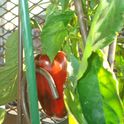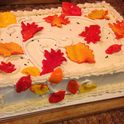what are the keys to getting perfect latkes? (besides eliminating excess moisture)
what are your tips for eliminating as much moisture as possible? what issues, large or small, have you encountered when making latkes? and what else should latke-makers keep in mind? thank you!
14 Comments
max J.December 5, 2015
Try par boiling your pot, then cover and leave to cool in the fridge overnight, make an olive oil roasting mixture. Dip the ice cold pots in the mixture so the oil congeals on the spuds, place tray in freezer so the mixture really hardens. Take out and roast in a hot oven!
Flavouring the oil coating, think potato chips.
Flavouring the oil coating, think potato chips.
Richard S.December 5, 2015
Duck fat! Schmaltz is great, but I never have enough (or any) on hand, but I buy duck fat online. The stuff is expensive, so I mix it 50/50 with rice bran will which has a neutral flavor and the highest smoke point of all the cooking oils. Ask any professional chef about the benefits of cooking potatoes in duck fat.
max J.December 5, 2015
http://www.waitrose.com/shop/ProductView-10317-10001-84159-Cooks'+Ingredients+goose+fat
max J.December 4, 2015
issues ? = indigestion. Cook in the king of schmaltz , single estate goose!
Leftovers rubbed on your chest gets rid of bronchitis and the evil eye!
Leftovers rubbed on your chest gets rid of bronchitis and the evil eye!
Lois S.December 4, 2015
Use yellow finn or yukon gold potatos and the small grating disk of the food processor- squeeze them and let drain in a colander over a bowl. Save the liquid and let the starch settle out. Add that starch back to your mixture. I bake in an a 450 convection oven using a pre-heated jelly roll pan with a lot oil on it. I don't fry bc I am lazy!
creamteaDecember 4, 2015
I use a blend of mostly russet Burbank potatoes and some Yukon Gold. If you are grating in a food processor, alternate the onion with the potato chunks to avoid or reduce darkening of the mixture. Grate on the coarse disc, squeeze (hard) the liquid out completely over a bowl and let it settle. Take a handful of the grated mixture back into the processor fitted with the steel blade and mince it fine, return this to the coarse mixture. Pour off liquid that has settled in the bowl, take the starch that has settled at the bottom of the bowl and stir that into the potatoes as a binder. Stir in the rest of the ingredients (salt pepper eggs etc.) Form into perfect discs by packing a little into the bottom of a small metal measuring cup--1/3 or 1/4 cup (don't fill it completely, just the bottom of the cup). You can actually form a few of them at a time on a plate as the predecessors are still frying. Sometimes I form and freeze them raw on wax paper in advance, then cook when I'm ready--works for me! If you do this you might add a sprinkle of lemon juice to keep the mixture white. Just a little. I like very traditional additions of sour cream (ok, crème fraîche) and home-made applesauce.
QueenSashyDecember 3, 2015
Keep the starch mixture!!! Let the potatoes rest for a couple of minutes and then squeeze excess water by hand. Reserve the water in a small bowl and leave it for about 15 minutes. After 15 minutes, pour off all the liquid from the bowl, but leave the white potato starch that settled on the bottom and mix it back with the rest of the stuff. The outcome: 1) your latkes are less likely to fall apart, 2) you don't need flour to bind them (or you will need less), 3) they will be yummy!
BeviDecember 3, 2015
I place the raw mixture in a tea towel and squeeze out the liquid until my hands hurt! I put the latkes in a warming oven because cold latkes are not pleasant. I like to very lightly salt the finished latkes with a touch of Kosher salt.
AntoniaJamesDecember 3, 2015
This is not a tip about the latkes themselves, but rather, just a reminder that the starchy water you squeeze out (using a thin tea towel, over a large bowl) should be saved and used in making bread. Substitute the liquid one for one with the water called for in the recipe. Potatoes in any form + yeasted bread dough = memorable. ;o)
sexyLAMBCHOPxDecember 3, 2015
I think Shmaltz (Traditional Ashkenazi preparation forEastern European Jews) is the key for its flavor and high heat point and also using some of the potato starch that comes from draining the potatoes slowly in a colander makes for amazing latkes. Tori Avery has a great article on latkes (history, tips, variations & dietary workarounds) Here it is and highly recommend her site for all things Jewish! http://toriavey.com/how-to/2013/11/how-to-make-crispy-latkes/
I like them crispy at the edges and softer in the middle and not too thin, so I'll pan fry and place in a low oven to keep warm. Super crispy? Serve right away! Latke preparations remind me of matzo balls, some like floaters, some like sinkers. Also, having various condiments - apple sauce, sour cream (with or w/o chopped dill), creme fraiche horseradish or ketchup - my favorite! This post makes miss Kukla!
I like them crispy at the edges and softer in the middle and not too thin, so I'll pan fry and place in a low oven to keep warm. Super crispy? Serve right away! Latke preparations remind me of matzo balls, some like floaters, some like sinkers. Also, having various condiments - apple sauce, sour cream (with or w/o chopped dill), creme fraiche horseradish or ketchup - my favorite! This post makes miss Kukla!
NancyDecember 3, 2015
One year, making them in a friend's house and with unfamiliar pots, there was no appropriate frypan.
So that year I made deep fried latkes.
Mm, so good! Best then and ever since. Why? because, as in frying at the right temps, the food cooks, the outside is crispy, and little/less oil is absorbed compared to cooking at lower temps.
However, some people still like the shape and texture of pan-fried, so sometimes when I'm making a big batch for a party, I will deep fry most and make a side selection of pan-fried for those who love them.
So that year I made deep fried latkes.
Mm, so good! Best then and ever since. Why? because, as in frying at the right temps, the food cooks, the outside is crispy, and little/less oil is absorbed compared to cooking at lower temps.
However, some people still like the shape and texture of pan-fried, so sometimes when I'm making a big batch for a party, I will deep fry most and make a side selection of pan-fried for those who love them.
louisezDecember 2, 2015
Make sure oil is hot enough. Do not turn till edges are brown. Turn over only once, to prevent them from getting soggy. Drain well.
Showing 14 out of 14 Comments
Recommended by Food52
Popular on Food52
Continue After Advertisement






